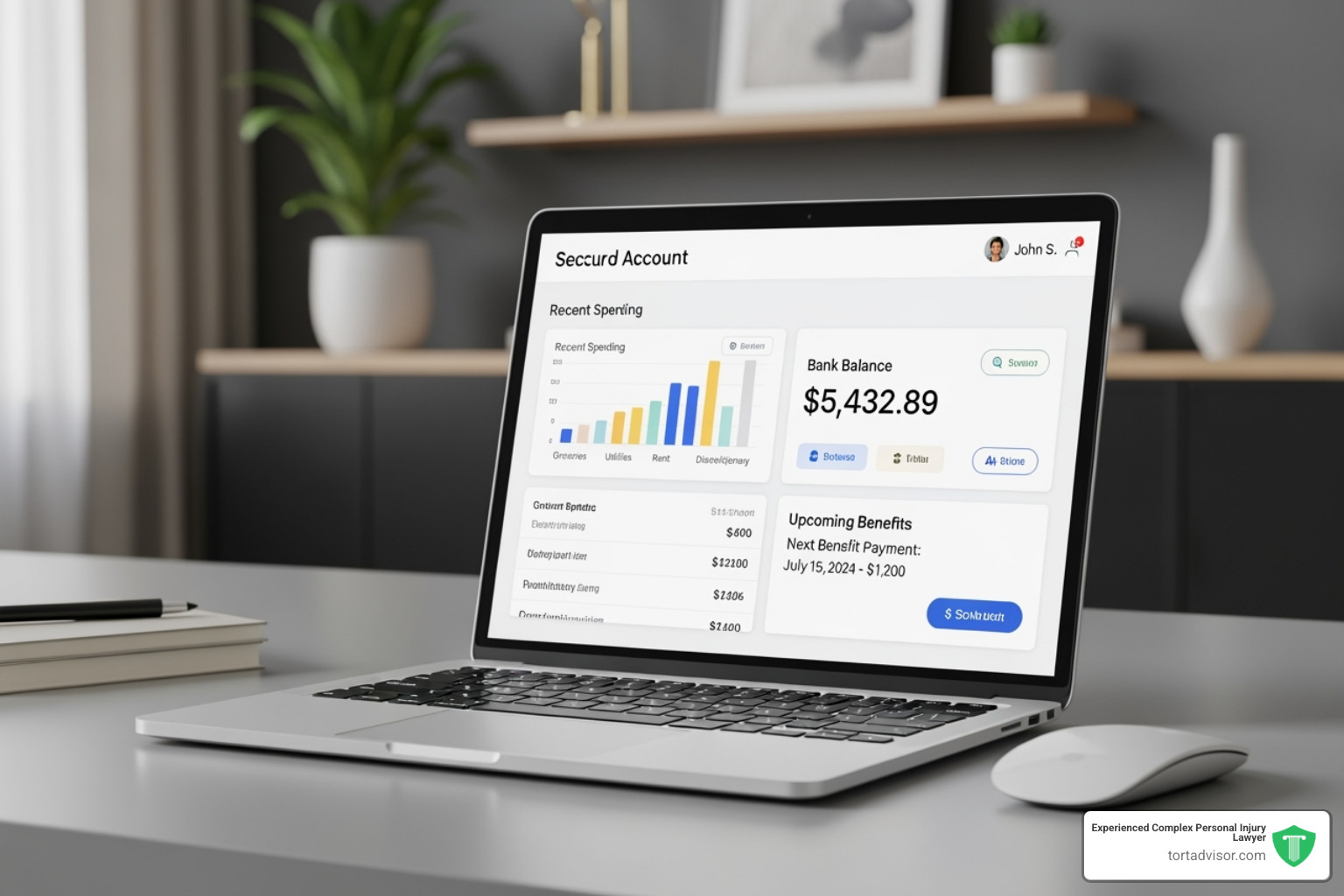

Why Understanding Your Social Security Benefits Matters
Social Security benefits provide monthly financial assistance to eligible Americans through four main programs: Retirement (for workers age 62+ with 10+ years of work history), Disability (SSDI for workers with qualifying conditions, and SSI for low-income individuals), Survivor (for family members of deceased workers), and Family (for dependents of beneficiaries). As of June 2025, over 69.8 million people receive these benefits, with average monthly payments ranging from $967 for SSI to $2,005 for retired workers.
Key Social Security Benefit Types:
- Retirement Benefits: Monthly payments starting at age 62 (reduced) or Full Retirement Age 66-67 (full amount)
- SSDI (Social Security Disability Insurance): For workers unable to work due to disability, average $1,582/month
- SSI (Supplemental Security Income): Needs-based program, maximum $967/month for individuals in 2025
- Survivor Benefits: For spouses, children, and parents of deceased workers
- Family Benefits: For dependents of retirement or disability beneficiaries, up to 50% of worker’s benefit
Most people think Social Security is just for retirement. That’s wrong.
If you’re dealing with a serious injury or disability that prevents you from working, you might qualify for disability benefits right now. About 8.2 million disabled workers and their families currently receive these benefits. But here’s the catch: most initial disability claims are denied.
The system is complicated. The rules interact in ways that aren’t obvious. Workers’ compensation can reduce your Social Security disability payments. You might qualify for multiple benefits at once. And making a mistake during the application process can cost you months of payments—or lead to an outright denial.
You need to know what you’re entitled to. You need to understand how these programs work together. And you need to get it right the first time.
I’m Mason Arnao, and while my background is in technology and SaaS systems, I’ve worked extensively with complex data systems and legal process automation that help people steer Social Security benefits claims. Through my work with legal technology platforms, I’ve seen how critical accurate information and proper guidance are when securing Social Security benefits.
Basic Social Security benefits vocab:
The Four Pillars of Social Security
Most people hear “Social Security” and think “retirement.” But the Social Security Administration (SSA) runs four distinct programs that can provide Social Security benefits right now, regardless of your age. Whether you’re injured, have lost a family breadwinner, or are caring for a dependent, a program may be available to help.
Throughout your career, you pay payroll taxes that earn you “work credits.” Most benefit types require 40 credits (about 10 years of work), but some benefits have different rules. Let’s break down each program.
Retirement Benefits
This is the most well-known program. After working for at least 10 years, you can receive monthly payments based on your lifetime earnings. You can start collecting at age 62, but your payment will be permanently reduced. If you wait until your Full Retirement Age (FRA)—66 or 67 depending on your birth year—you receive your full benefit. Waiting past your FRA until age 70 increases your monthly payment. Even if you haven’t worked, you may qualify for spousal benefits of up to 50% of your partner’s full retirement amount.
Disability Benefits (SSDI & SSI)
If a medical condition stops you from working, Social Security offers two disability programs:
- Social Security Disability Insurance (SSDI) is for those who have worked and paid into the system. To qualify, you must be unable to perform Substantial Gainful Activity (SGA) due to a medical condition expected to last at least 12 months or result in death. More details are on the Social Security Disability Insurance (SSDI) page.
- Supplemental Security Income (SSI) is a needs-based program for those with limited income and resources, regardless of work history. If you are disabled, blind, or over 65 and meet the financial limits, you may qualify. Learn more about Supplemental Security Income (SSI) on the SSA website.
Some people can receive both SSDI and SSI if their work history qualifies them for a low SSDI payment and they also meet SSI’s financial need criteria.
Survivor Benefits
When a worker who paid into Social Security dies, their family may be eligible for survivor benefits. These benefits for spouses and other survivors are based on the deceased’s earnings. Eligible recipients include widows/widowers (as early as age 60, or 50 if disabled), minor children, adult children disabled before age 22, and dependent parents. These payments can provide crucial financial stability after a loss.
Family Benefits
Social Security can also support your dependents while you are alive and receiving retirement or disability benefits. Your spouse (age 62+ or caring for your child under 16) and unmarried children under 18 can receive payments. Ex-spouses may also qualify if the marriage lasted 10+ years. Each eligible family member can receive up to 50% of your full benefit, subject to a family maximum.
A Deep Dive into Disability: SSDI vs. SSI
One of the biggest sources of confusion in the Social Security benefits world is the difference between SSDI and SSI. They both help people with disabilities, but they are fundamentally different programs. Knowing which you qualify for is critical.
| Criteria | Social Security Disability Insurance (SSDI) | Supplemental Security Income (SSI) |
|---|---|---|
| Work History Req. | Yes, sufficient work credits earned by paying Social Security taxes. | No, not based on work history. |
| Financial Need | No, not a needs-based program. Benefits are based on earnings record. | Yes, for individuals with limited income and resources. |
| Benefit Calc. | Based on Average Indexed Monthly Earnings (AIME) and Primary Insurance Amount (PIA). | Federal maximum monthly benefit, reduced by other countable income. |
| Health Insurance | Medicare (after a 24-month waiting period). | Medicaid (typically, in most states). |
What is the Difference Between SSDI and SSI?
Think of SSDI as an insurance policy you’ve earned through your payroll taxes. Your eligibility and benefit amount for Social Security Disability Insurance (SSDI) depend on your work and earnings history, not your current assets.
SSI, or Supplemental Security Income (SSI), is a needs-based program. It’s for people with disabilities (or those who are blind or elderly) who have very limited income and resources, regardless of their work history.
It’s possible to receive “concurrent benefits”—both SSDI and SSI—if your SSDI payment is low and you also meet SSI’s strict financial limits. In this case, SSI supplements your SSDI payment.
How are Social Security Disability Benefits Calculated?
The SSDI benefit formula is complex. The SSA reviews your lifetime earnings, adjusts them for inflation, and averages your highest 35 years of earnings to find your Average Indexed Monthly Earnings (AIME). This AIME is then used in a formula to determine your Primary Insurance Amount (PIA), which is your base benefit. The formula is progressive, replacing a higher percentage of income for lower-wage earners. For a personalized estimate, the SSDI Benefit Calculator can be a helpful tool.
How Do Other Payments Affect Your Benefits?
Other income can reduce your Social Security benefits, particularly disability payments. The most common issue is the workers’ compensation offset. If you receive workers’ comp, your combined benefits (workers’ comp + SSDI) generally cannot exceed 80% of your average earnings before you became disabled. If they do, your SSDI payment will be reduced. Public disability benefits from state or local governments can also cause an offset. However, private pensions, veterans’ benefits, and SSI payments do not reduce your SSDI benefits. These calculations can be tricky, making expert guidance crucial in complex cases.
A Closer Look at Your Social Security Benefits and How to Secure Them
Getting approved for Social Security benefits, especially for disability, is a challenge. Many initial claims are denied, often due to incomplete paperwork or medical records. Understanding the multi-stage application and appeals process is key to success.
Step-by-Step: Applying for Disability Benefits
You can apply for disability benefits online, by phone, or in-person. Whichever method you choose, thoroughness is vital. The SSA requires detailed information about your medical condition, treatment history, medications, and work history. Before you start, gather all your required documents, including medical records, lab results, and earnings statements. A complete and accurate application is your first and best step toward approval.
What to Do if You Have a Denied Disability Claim
Most initial disability applications are denied. It’s discouraging, but a denial is not the end. You have 60 days from the date on your denial letter to file an appeal. This deadline is strict.
The appeals process has several levels:
- Reconsideration: A new examiner reviews your file. This is your chance to submit new medical evidence.
- Administrative Law Judge (ALJ) Hearing: This is where many claims are won. You can present your case in person to a judge, bring witnesses, and have legal representation.
- Appeals Council: If the ALJ denies your claim, you can ask the Appeals Council to review the decision.
- Federal Court: The final step is filing a lawsuit in federal court.
Persistence is crucial. Don’t give up after the first denial. For more guidance, see our resource on what to do after a Denied Disability Claim.
Where to Find Disability Claim Assistance
The rules for Social Security benefits are complex and the paperwork can be overwhelming. While the SSA offers resources and can be contacted directly for general questions, building a strong case often requires specialized help.
An experienced attorney understands what the SSA needs to see. They can help you gather the right medical evidence, present your case effectively at a hearing, and steer complex situations like benefit offsets. Most Social Security Disability attorneys work on contingency, meaning they only get paid if you win. For comprehensive Disability Claim Assistance, Tort Advisor connects clients with top-rated specialty attorneys who have proven results in this area.
Planning and Management: Taking Control of Your Benefits
Once you’re receiving Social Security benefits, staying engaged is key to ensuring you get everything you’re entitled to. The SSA’s online tools make managing your benefits easier than ever.
Using Your ‘my Social Security’ Account
Your “my Social Security” account is a free, secure portal for managing your benefits. If you don’t have one, you can Create an Account in minutes. This online dashboard allows you to:
- Check your application status.
- Get an instant benefit verification letter.
- Review your Social Security Statement, which shows your full earnings record and estimates future benefits.
- Set up or change direct deposit information.
- Report changes to your address or phone number.
- Access your annual tax forms (SSA-1099).
Using this portal puts you in control and helps you keep your information up-to-date.
When Are Benefits Paid?
Social Security benefits follow a predictable monthly schedule based on your birth date.
- Born 1st-10th: Paid on the second Wednesday of the month.
- Born 11th-20th: Paid on the third Wednesday.
- Born 21st-31st: Paid on the fourth Wednesday.
People who started receiving benefits before May 1997 or who receive both Social Security and SSI are paid on the third of each month. The SSA recommends direct deposit for safe and reliable payments. You can find the official schedule here: Find out when you will get paid.
Debunking Common Social Security Myths
Misconceptions about Social Security benefits can lead to costly mistakes. Let’s set the record straight on some of the biggest myths.
- “It’s only for retirees.” False. Millions of Americans under 65 receive disability or survivor benefits. Social Security provides a safety net for disabled workers, children who lose a parent, and other dependents.
- “Your taxes go into a personal account.” Not true. Social Security is a “pay-as-you-go” system. Today’s workers’ taxes pay for current beneficiaries’ benefits. Your contributions earn you credits toward future benefits, but there is no individual account with your name on it.
- “You should claim benefits as soon as you turn 62.” This can be a costly choice. Claiming at 62 permanently reduces your monthly payment by up to 30%. Waiting past your Full Retirement Age (until 70) increases your payment. The right time to claim depends on your health, finances, and life expectancy.
- “If you’ve never worked, you can’t get Social Security.” Not necessarily. A non-working person may be able to receive spousal benefits based on their partner’s work record.
- “Your benefits are based on your last few years of work.” The SSA actually calculates benefits based on your highest 35 years of earnings over your entire career, adjusted for wage inflation.
- “Most disability claims are approved on the first try.” The opposite is true. Many initial applications are denied, often due to documentation issues. The appeals process is where many deserving claimants are ultimately approved.
- “You can’t work at all while receiving SSDI.” The SSA has work incentive programs, like the Trial Work Period, that allow you to test your ability to work for up to nine months without losing benefits.
- “SSDI replaces your full income.” No. SSDI is a safety net, typically replacing only 40-50% of your previous earnings.
Understanding these truths helps you make better decisions about your Social Security benefits.
Frequently Asked Questions about Social Security
We’re here to answer some of the most common questions we encounter about Social Security benefits.
Can I work while receiving disability benefits?
Yes, you can work while receiving disability Social Security benefits, but there are strict rules. The SSA uses an earnings limit called “Substantial Gainful Activity” (SGA) to determine eligibility. For 2025, the SGA limit is $1,620 per month for non-blind individuals. If you consistently earn more than this, the SSA may determine you are no longer disabled.
However, the SSA offers “Work Incentive Programs” to help you return to work. The “Trial Work Period” (TWP) allows you to earn any amount for up to nine months without losing your benefits. After the TWP, an “Extended Period of Eligibility” provides a safety net for 36 months, where you receive benefits for any month your earnings are below the SGA limit. It is critical to report all work and earnings to the SSA immediately to avoid penalties.
How are retirement benefits calculated?
The SSA calculates your retirement benefit by first adjusting your lifetime earnings for wage inflation. They then average your 35 highest-earning years to determine your “Average Indexed Monthly Earnings” (AIME). This AIME is put through a formula to find your “Primary Insurance Amount” (PIA), which is your full benefit amount at your Full Retirement Age (FRA), between age 66 and 67.
Claiming early at age 62 results in a permanently reduced payment. Delaying your claim past your FRA until age 70 increases your monthly benefit through “delayed retirement credits.” The best time to claim depends on your personal circumstances.
Are Social Security benefits taxable?
Yes, your Social Security benefits may be subject to federal income tax, depending on your “combined income.” To calculate this, add your adjusted gross income, any non-taxable interest, and half of your Social Security benefits.
- Individuals: Up to 50% of benefits may be taxed if combined income is $25,000-$34,000. Up to 85% may be taxed if income is over $34,000.
- Couples filing jointly: Up to 50% may be taxed if income is $32,000-$44,000. Up to 85% may be taxed if income is over $44,000.
This means a portion of your benefits is added to your taxable income; you don’t lose that percentage of your benefits. Some states also tax benefits, so check your local laws.
Conclusion
Navigating Social Security benefits can be overwhelming. The system is far more than just a retirement program; it’s a crucial safety net for millions of Americans facing disability, the loss of a loved one, or other life challenges.
However, securing these benefits is rarely simple. The rules are complex, and initial disability claims are often denied due to simple errors or incomplete documentation. Details like your earnings record, medical evidence, and appeal deadlines can make or break your claim. Using your “my Social Security” account is an essential tool for managing your information and preventing problems.
For straightforward questions, the SSA’s resources are helpful. But when you face a denied claim, a complex appeal, or confusing benefit offsets, expert legal guidance is invaluable. At Tort Advisor, we connect clients with top-rated specialty attorneys who know the system inside and out. They have a proven track record of success and understand how to build a winning case, often at the critical Administrative Law Judge hearing stage.
You’ve paid into this system your entire career. These are benefits you have earned. Don’t let complexity prevent you from receiving the financial security you deserve. We’re here to help you secure your entitlements.
Free Confidential Case Evaluation
Complete the short form below to get an immediate FREE case review with an expert in your specific claim. Don't wait, your case could be time sensitive to file a claim.
Related Posts
Did a North Dakota product cause harm? Understand product liability, your rights, and how to take action for defects.
Get justice for clergy abuse. Find an expert Priest abuse lawyer to navigate complex laws and hold institutions accountable.
Diagnosed with meningioma after Depo-Provera? Understand potential Depo-Provera lawsuit settlements, risks, & how to claim compensation.
Uncover the truth about uber sexual assault cases. Learn about the alarming scale, Uber's accountability, and legal options for justice.
Facing wildfire losses? Discover the best wildfire lawsuit attorneys in California to fight for your full recovery and justice.
Exposed to Roundup & diagnosed with NHL? Discover how to sue Monsanto, understand eligibility, & seek compensation. Your guide to justice.










